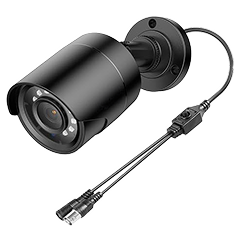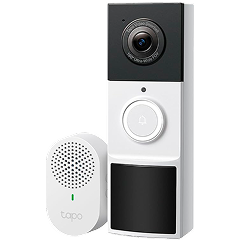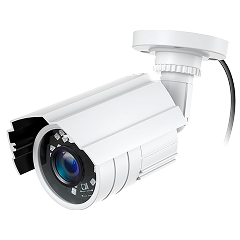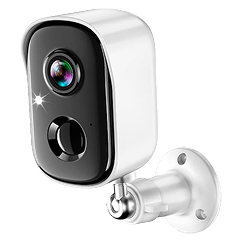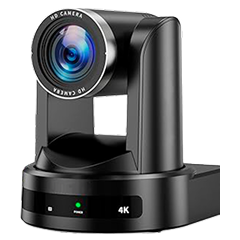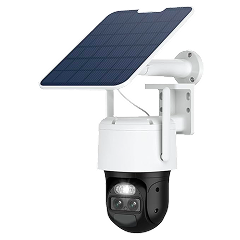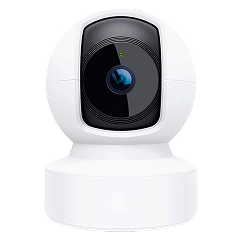After installing Ring cameras with solar panels at my old house, then switching to a wired setup when I moved, I’ve learned that solar cameras solve problems you don’t realize you have until you need them.
Running cables to my garage would have cost more than the camera itself, and my previous house had zero outdoor outlets near the areas I wanted to monitor. Solar cameras let me put cameras exactly where intruders actually approach, not just where power happens to be available.
What most camera companies won’t tell you: solar panels produce drastically less power in winter, batteries die faster than you expect during cloudy stretches, and that expensive 6W panel might save you from constantly dead cameras.
I spent two years constantly tweaking my Ring cameras because the “solar-powered” promise turned into “check batteries monthly,” especially after December, when my panels barely generated enough power to keep a flashlight running. However, I live in Northern Indiana and get significantly less sun in the winter compared to the Southeast and Southwest U.S. So, your results will vary.
Solar Panel Performance and Charging Efficiency
That wattage rating? It’s what you get under perfect lab conditions that never exist in real life.
Wattage Requirements and Real-World Performance
Panel wattage matters more than any other spec because it determines whether your camera actually stays powered year-round. My 4W Ring panels worked perfectly from April through September, keeping batteries topped off even with daily motion alerts. But when winter hit and daylight dropped to eight hours with frequent overcast skies, those same panels barely maintained existing battery charge, let alone recovered from heavy recording days. The 6W+ panels cost about 40% more but generate enough surplus during good weather to carry you through week-long cloudy stretches without the camera going dark.
Panel Types and Efficiency Differences
Three types of solar panels exist, but good luck finding out which one your camera uses from the product specs.
Monocrystalline panels grab more power during early morning and late afternoon hours, explaining why you’ll pay twice as much for some camera systems even when the wattage looks identical.
Geographic and Seasonal Considerations
Your location determines whether solar cameras make sense or become a winter maintenance headache. Indiana gets plenty of sunshine most of the year, but much less in the winter.
My cameras went dead when a January snowstorm buried the panels for days. Southern folks can probably get away with basic setups, while those of us dealing with real winters need oversized everything.
Battery Capacity Requirements for Solar Systems
Your battery capacity decides if cameras keep working through bad weather or go dark exactly when you need them. The 10,000mAh batteries in my Ring cameras lasted about three days without any solar input during moderate use, but high-traffic areas with frequent motion alerts drained them in under two days. February brought a solid week of clouds, and two cameras died on me, creating blind spots right when I needed coverage most. The expensive 15,000mAh cameras would’ve kept running like nothing happened.
Freezing weather destroys battery performance beyond just the solar charging problem. My 10,000mAh batteries turned into 7,000mAh units once temperatures dropped below 32 degrees. Combined with reduced solar input, winter creates a perfect storm for dead cameras. I started checking battery levels weekly during winter months and learned to dial back motion sensitivity during extended cold snaps to preserve power.
Battery capacity recommendations by installation type:
- 15,000+ mAh: High-traffic driveways, front doors, commercial properties
- 10,000-14,999 mAh: Standard residential monitoring, moderate activity areas
- 7,500-9,999 mAh: Low-activity perimeter monitoring, seasonal properties
- Below 7,500 mAh: Avoid for solar setups – insufficient backup capacity
Solar Panel Technology and Integration
Camera makers rarely specify which solar technology they use, despite major performance differences between types. Monocrystalline costs more upfront but delivers better power density and shade tolerance compared to cheaper alternatives. The physical integration matters just as much.
My Ring solar panels attached directly to the camera housing, which created wind resistance that loosened mounting screws over time. Separate panel mounting with extension cables costs more to install, but lets you optimize solar positioning independently from camera angles.
Solar integration options and trade-offs:
- Integrated panels: Simpler installation, single mounting point, limited positioning flexibility
- Separate panel mounting: Optimal solar positioning, reduced wind load on camera, requires additional hardware
- Adjustable panel arms: Best positioning flexibility, more complex mounting, additional failure points
- Fixed panel attachment: Lower cost, fewer moving parts, compromised solar angles
- Extension cable systems: Maximum positioning freedom, weather-sealed connections required, higher installation cost
Installation Positioning Strategy
The biggest mistake I made was mounting cameras in perfect security positions first, then discovering the solar panels couldn’t get enough sun to keep them running.
Optimizing for Solar vs. Security Coverage
Every solar camera installation becomes a compromise between ideal security angles and optimal solar exposure. My garage camera needed to face north to cover the driveway approach, but the solar panel attached to it barely got four hours of direct sunlight even in summer.
I ended up relocating the camera 15 feet east, where it still covered the critical area, but the panel could face south. Extension cables let you position panels independently, though you’re adding extra connections that could fail and weatherproofing headaches most people don’t want to mess with.
Environmental Factors
Six hours of direct southern sun sounds easy until you realize that maple trees grow taller and wider each year, and seasonal shadows move around. My back patio tree gave perfect summer shade but completely blocked the camera’s panel from late fall through early spring, forcing me to relocate the camera.
Wind load becomes a serious issue with larger solar panels. My 6W panel caught enough wind during storms to shake the camera and create blurry footage. Plan for panel cleaning access, too, because dust and pollen accumulation can cut solar output by 20% or more.
Solar-Specific Features and Technology
Smart charging systems separate decent solar cameras from cheap ones that kill batteries through poor power management. Look for cameras with battery health monitoring that shows actual charge levels and solar input rates through the mobile app. This saved me from multiple dead camera situations by alerting me when panels weren’t generating expected power due to dirt buildup or shading issues.
Temperature compensation matters more than most people realize because lithium batteries charge differently in extreme heat or cold, and cameras without this feature either undercharge in winter or damage batteries in summer heat. The best systems include low-power modes that automatically reduce recording quality and motion sensitivity when solar input drops below battery consumption, keeping cameras functional during extended cloudy periods instead of just dying completely.
Cost Analysis and Solar Value Proposition
Solar cameras cost 30-50% more than standard wireless models, but the math works out if you factor in battery replacement costs and installation flexibility. My Ring solar setup cost an extra $150 for three panels, but I avoided running low-voltage power to remote locations that would have cost $300+ per camera location.
Over three years, I spent maybe $40 on replacement batteries compared to the $180+ I would have needed for non-solar cameras with regular battery swaps. The break-even point hits around 18-24 months if you’re diligent about maintenance and positioning.
Professional installation makes sense for solar cameras only when optimal panel positioning requires roof mounting or complex cable runs. I handled my own installation using basic tools and a ladder, but my neighbor hired an electrician for his setup because his ideal solar exposure was on a second-story roof.
Installation costs run $100-$200 per camera for basic mounting, but can hit $300+ if panel positioning requires separate mounting hardware or extensive cable management. Skip the professional install if your panels can mount directly to the camera housing and you have clear ground-level access to optimal sun exposure.
Common Solar Camera Mistakes
Here are the installation and performance mistakes that cost me time, money, or security coverage during my three years running solar cameras.
Installation and setup errors:
- Underestimating winter sun angle changes – My panels got full summer sun but were shaded by roof overhangs from November through February.
- Insufficient battery capacity for local climate – 10,000mAh batteries worked fine until I hit a week of cloudy weather, and two cameras died.
- Prioritizing security angles over solar exposure – I mounted cameras for perfect coverage first, then discovered panels couldn’t charge properly in those positions.
Performance expectation mismatches:
- Believing manufacturer solar claims – Ring’s “maintenance-free solar charging” turned into monthly battery monitoring during winter months.
- Setting motion sensitivity too high – Cranked-up sensitivity drained batteries faster than solar panels could recharge them during active periods.
- Ignoring seasonal performance drops – Summer performance lulled me into thinking the system was bulletproof until December reality hit.
Maintenance and monitoring oversights:
- Skipping regular panel cleaning – Dust and pollen buildup cut charging efficiency by 20% before I noticed the problem.
- Not monitoring battery health degradation – Original batteries lost 30% capacity after two years, requiring replacement despite solar charging.
- Assuming solar panels last forever – Panel efficiency degrades over time, and cheap panels fail much faster than quality ones.
How to Pick the Right Solar Security Cameras for Your Home
Start with your property’s solar exposure and work backward to camera specs. Walk around your house during different seasons and identify locations that get six-plus hours of direct sunlight year-round. These spots can handle smaller 4W panels and standard batteries. Shady spots or north-facing locations demand 6W+ panels paired with hefty 15,000mAh batteries to work reliably. Detached buildings and property corners justify solar’s added cost, but locations near power outlets probably don’t warrant the extra hassle.
Focus on the specs that matter most: panel wattage first, battery capacity second, then standard camera features like resolution and weather rating. Avoid budget solar cameras with tiny panels or batteries under 7,500mAh. They’ll frustrate you with dead cameras during cloudy stretches. Spend the extra money on proven brands with good mobile apps for monitoring solar performance, because you’ll need that visibility to catch problems before your cameras go offline. Our main wireless camera guide covers brands, video specs, and smart home stuff if you want more details.


